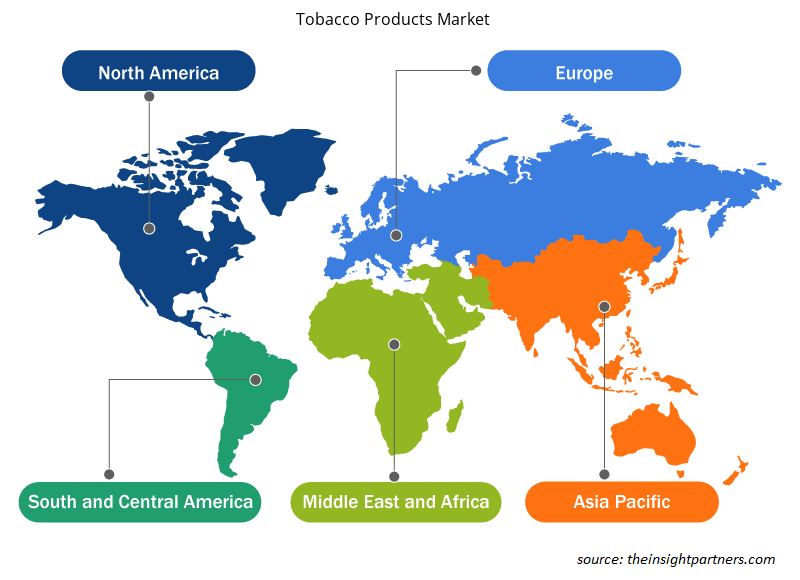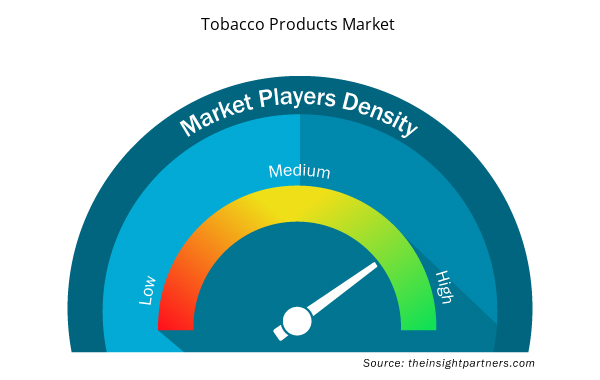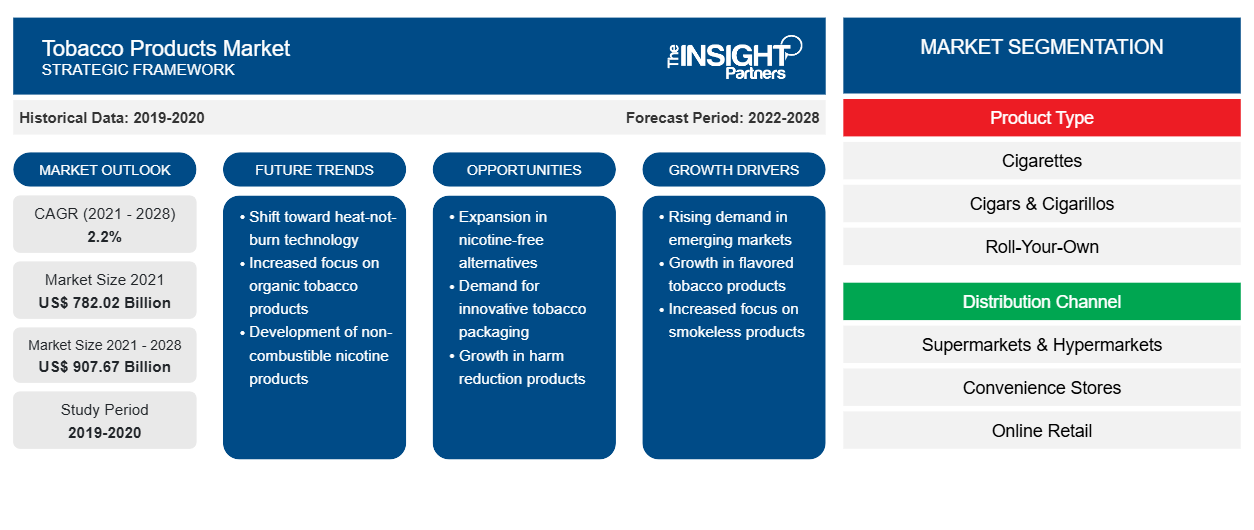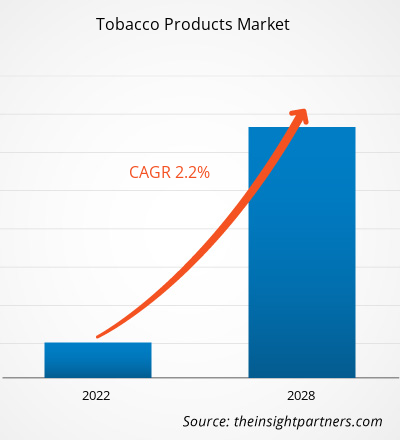Si prevede che il mercato dei prodotti del tabacco raggiungerà i 907.665,43 milioni di dollari entro il 2028, rispetto ai 782.022,19 milioni di dollari del 2021. Si prevede che crescerà a un CAGR del 2,2% dal 2021 al 2028.
Le foglie di tabacco di diverse varietà, come Virginia e Burley , vengono miscelate per produrre prodotti come sigarette , sigari e sigarilli e tabacco da arrotolare. Il consumo di tabacco e prodotti correlati è aumentato in tutto il mondo durante il periodo di rallentamento economico a causa del calo dei mercati azionari e delle esecuzioni immobiliari, e dello stress correlato ai licenziamenti, che ha spinto molte persone a cercare rifugio nel fumo. Il tabacco è una delle sostanze che creano dipendenza più comuni utilizzate al mondo. Contribuisce inoltre alla maggior parte delle entrate fiscali per varie nazioni nelle economie sviluppate e in via di sviluppo.
L'Asia-Pacifico ha detenuto la quota maggiore del mercato dei prodotti del tabacco nel 2020, mentre si prevede che il Medio Oriente e l'Africa registreranno un CAGR significativo nel mercato durante il periodo di previsione. I principali attori che operano nel mercato dei prodotti del tabacco stanno espandendo le loro operazioni in Medio Oriente e Africa grazie alla potenziale base di clienti, alle leggi favorevoli e al panorama della vendita al dettaglio in rapida evoluzione in tutta la regione.
Personalizza questo report in base alle tue esigenze
Riceverai la personalizzazione gratuita di qualsiasi report, comprese parti di questo report, o analisi a livello nazionale, pacchetto dati Excel, oltre a usufruire di grandi offerte e sconti per start-up e università
- Scopri le principali tendenze di mercato in questo rapporto.Questo campione GRATUITO includerà analisi di dati che spaziano dalle tendenze di mercato alle stime e alle previsioni.
Impatto della pandemia di COVID-19 sul mercato dei prodotti del tabacco
La pandemia di COVID-19 ha portato sfide senza precedenti per molti settori all'inizio del 2020. Lockdown , restrizioni alle frontiere, divieti di viaggio, interruzione della produzione e altre misure di sicurezza implementate dai governi secondo le linee guida dell'OMS e dei ministeri della salute nazionali hanno ostacolato le operazioni di produzione. D'altro canto, secondo gli studi condotti dall'American College of Physicians, durante i primi 16 mesi della pandemia di COVID-19, le vendite di sigarette negli Stati Uniti sono state maggiori del previsto. La maggior parte delle aziende produttrici di tabacco ha assistito a un'impennata della domanda di prodotti del tabacco senza fumo o riscaldati e di prodotti del tabacco da masticare durante la pandemia. Tuttavia, hanno dovuto affrontare un leggero calo delle vendite al dettaglio di viaggi a causa dei divieti di viaggio.
Approfondimenti di mercato
La crescente domanda di prodotti del tabacco non combustibili stimola la crescita del mercato
A causa delle crescenti preoccupazioni per la salute legate al consumo di prodotti del tabacco combustibili, i governi hanno incoraggiato le aziende a introdurre diverse leggi e normative per tenere sotto controllo il consumo di tabacco. Hanno aumentato le tasse sul tabacco combustibile e abbassato i prezzi del tabacco non combustibile. Ciò ha portato a una maggiore adozione di prodotti non combustibili, come le sigarette elettroniche. Ad esempio, il governo del Regno Unito ha adottato un approccio olistico aumentando significativamente le tasse sui prodotti del tabacco combustibili e abbassando le tasse sui prodotti non combustibili. Ciò ha aumentato l'adozione delle sigarette elettroniche nel mercato del Regno Unito, riducendo significativamente i tassi di prevalenza del fumo nel paese. I produttori hanno anche sviluppato prodotti del tabacco orale, non combustibile o senza fumo nella categoria dei prodotti a rischio ridotto ( RRP ).
Informazioni sul tipo di prodotto
In base al tipo di prodotto, il mercato dei prodotti del tabacco è suddiviso in sigarette, sigari e sigarilli, roll-your-own e altri. Si prevede che il segmento degli altri prodotti del tabacco registrerà il CAGR più elevato durante il periodo di previsione. Questo segmento include sigarette elettroniche, vaporizzatori, snus e solubili. La crescente consapevolezza dei danni causati dai prodotti del tabacco combustibili sta guidando la domanda di prodotti del tabacco non combustibili, come sigarette elettroniche, vaporizzatori e prodotti del tabacco da masticare.
Informazioni sui canali di distribuzione
In base al canale di distribuzione, il mercato dei prodotti del tabacco è stato segmentato in supermercati e ipermercati, minimarket, vendita al dettaglio online e altri. Si prevede che il segmento della vendita al dettaglio online registrerà il CAGR più elevato nel mercato durante il periodo di previsione. La vendita al dettaglio online offre agli utenti un'esperienza di acquisto comoda, seguita da una consegna semplificata dei prodotti. I negozi al dettaglio online offrono un'ampia gamma di prodotti con forti sconti; inoltre, i consumatori possono comodamente acquistare prodotti desiderabili da remoto. I servizi di consegna a domicilio incoraggiano un gran numero di consumatori ad acquistare tramite portali di e-commerce.
I principali attori che operano nel mercato dei prodotti del tabacco includono Altria Group, Inc.; British American Tobacco plc; Swedish Match AB; ITC Ltd.; Japan Tobacco International; Imperial Brands; Philip Morris Products SA; Vector Group LTD.; Pyxus International, Inc.; e China Tobacco International (HK) Company Limited. Questi attori sono impegnati nello sviluppo di prodotti con rischi per la salute ridotti per soddisfare le tendenze emergenti dei consumatori, oltre a rispettare i quadri normativi. Sono coinvolti in fusioni e acquisizioni, espansioni aziendali e partnership per espandere la loro quota di mercato.
Approfondimenti regionali sul mercato dei prodotti del tabacco
Le tendenze regionali e i fattori che influenzano il mercato dei prodotti del tabacco durante il periodo di previsione sono stati ampiamente spiegati dagli analisti di Insight Partners. Questa sezione discute anche i segmenti e la geografia del mercato dei prodotti del tabacco in Nord America, Europa, Asia Pacifico, Medio Oriente e Africa e America meridionale e centrale.

- Ottieni i dati specifici regionali per il mercato dei prodotti del tabacco
Ambito del rapporto sul mercato dei prodotti del tabacco
| Attributo del report | Dettagli |
|---|---|
| Dimensioni del mercato nel 2021 | 782,02 miliardi di dollari USA |
| Dimensioni del mercato entro il 2028 | 907,67 miliardi di dollari USA |
| CAGR globale (2021 - 2028) | 2,2% |
| Dati storici | 2019-2020 |
| Periodo di previsione | 2022-2028 |
| Segmenti coperti | Per tipo di prodotto
|
| Regioni e Paesi coperti | America del Nord
|
| Leader di mercato e profili aziendali chiave |
|
Densità degli attori del mercato dei prodotti del tabacco: comprendere il suo impatto sulle dinamiche aziendali
Il mercato dei prodotti del tabacco sta crescendo rapidamente, spinto dalla crescente domanda degli utenti finali dovuta a fattori quali l'evoluzione delle preferenze dei consumatori, i progressi tecnologici e una maggiore consapevolezza dei benefici del prodotto. Con l'aumento della domanda, le aziende stanno ampliando le loro offerte, innovando per soddisfare le esigenze dei consumatori e capitalizzando sulle tendenze emergenti, il che alimenta ulteriormente la crescita del mercato.
La densità degli operatori di mercato si riferisce alla distribuzione di aziende o società che operano in un particolare mercato o settore. Indica quanti concorrenti (operatori di mercato) sono presenti in un dato spazio di mercato in relazione alle sue dimensioni o al valore di mercato totale.
Le principali aziende che operano nel mercato dei prodotti del tabacco sono:
- Altria Group, Inc.
- Società per azioni British American Tobacco plc.
- Partita svedese AB
- Società anonima ITC Ltd.
- Tabacco del Giappone Internazionale
Disclaimer : le aziende elencate sopra non sono classificate secondo un ordine particolare.

- Ottieni una panoramica dei principali attori del mercato dei prodotti del tabacco
Segnala i riflettori
- Tendenze industriali progressive nel mercato dei prodotti del tabacco per aiutare gli operatori a sviluppare strategie efficaci a lungo termine
- Strategie di crescita aziendale adottate per garantire la crescita nei mercati sviluppati e in via di sviluppo
- Analisi quantitativa del mercato dei prodotti del tabacco dal 2019 al 2028
- Stima della domanda globale di prodotti del tabacco
- Analisi delle cinque forze di Porter per illustrare l'efficacia degli acquirenti e dei fornitori che operano nel settore
- Sviluppi recenti per comprendere lo scenario competitivo del mercato
- Tendenze e prospettive del mercato, nonché fattori che regolano la crescita del mercato dei prodotti del tabacco
- Assistenza nel processo decisionale evidenziando le strategie di mercato che sostengono l'interesse commerciale, portando alla crescita del mercato
- Dimensioni del mercato dei prodotti del tabacco in vari nodi
- Panoramica dettagliata e segmentazione del mercato e dinamiche del settore del tabacco
- Dimensioni della crescita in diverse regioni con promettenti opportunità di crescita
- Analisi storica (2 anni), anno base, previsione (7 anni) con CAGR
- Analisi PEST e SWOT
- Valore/volume delle dimensioni del mercato - Globale, regionale, nazionale
- Industria e panorama competitivo
- Set di dati Excel



Report Coverage
Revenue forecast, Company Analysis, Industry landscape, Growth factors, and Trends

Segment Covered
This text is related
to segments covered.

Regional Scope
North America, Europe, Asia Pacific, Middle East & Africa, South & Central America

Country Scope
This text is related
to country scope.
Domande frequenti
The global tobacco products market is primarily driven by the rising consumption of tobacco products in developing regions such as Asia-Pacific and the Middle East & Africa.
Based on product type, the other tobacco products segment is projected to grow at the fastest CAGR. Other tobacco products include e-cigarettes & vapes, snus, dissolvable, among others. The growing awareness about the hazardous effects of smoking among consumers is driving the demand for e-cigarettes, vapes, and snus.
Based on distribution channel, the supermarkets and hypermarkets segment held the largest market share owing to high customer traffic in these stores coupled with availability of different brands of tobacco products under one roof.
In 2020, Asia-Pacific led the global tobacco products market owing to the rising number of tobacco consumers across India, China, Japan, among other countries, changing lifestyles of people, increasing disposable income level, and easy available of different brands of tobacco products in the region
The tobacco products market is highly regulated. The manufacturers of tobacco products have to comply with stringent packaging and labeling regulations set by various regulatory bodies across different countries. Moreover, there are few yet dominant market players having strong distribution network and well-established customer base. Further, governments of different nations impose high duties on tobacco products to minimize their consumption. These are some of the entry barriers in the market.
Some of the prominent players operating in the global tobacco products market include Altria Group, Inc.; British American Tobacco plc; Swedish Match AB; ITC Ltd.; Japan Tobacco International; Imperial Brands; Philip Morris Products S.A.; Vector Group LTD.; Pyxus International, Inc.; and China Tobacco International (HK) Company Limited.
Trends and growth analysis reports related to Consumer Goods : READ MORE..
The List of Companies - Tobacco Products Market
- Altria Group, Inc.
- British American Tobacco plc.
- Swedish Match AB
- ITC Ltd.
- Japan Tobacco International
- Imperial Brands
- Philip Morris Products S.A.
- Vector Group LTD.
- Pyxus International, Inc.
- China Tobacco International (HK) Company Limited
The Insight Partners performs research in 4 major stages: Data Collection & Secondary Research, Primary Research, Data Analysis and Data Triangulation & Final Review.
- Data Collection and Secondary Research:
As a market research and consulting firm operating from a decade, we have published and advised several client across the globe. First step for any study will start with an assessment of currently available data and insights from existing reports. Further, historical and current market information is collected from Investor Presentations, Annual Reports, SEC Filings, etc., and other information related to company’s performance and market positioning are gathered from Paid Databases (Factiva, Hoovers, and Reuters) and various other publications available in public domain.
Several associations trade associates, technical forums, institutes, societies and organization are accessed to gain technical as well as market related insights through their publications such as research papers, blogs and press releases related to the studies are referred to get cues about the market. Further, white papers, journals, magazines, and other news articles published in last 3 years are scrutinized and analyzed to understand the current market trends.
- Primary Research:
The primarily interview analysis comprise of data obtained from industry participants interview and answers to survey questions gathered by in-house primary team.
For primary research, interviews are conducted with industry experts/CEOs/Marketing Managers/VPs/Subject Matter Experts from both demand and supply side to get a 360-degree view of the market. The primary team conducts several interviews based on the complexity of the markets to understand the various market trends and dynamics which makes research more credible and precise.
A typical research interview fulfils the following functions:
- Provides first-hand information on the market size, market trends, growth trends, competitive landscape, and outlook
- Validates and strengthens in-house secondary research findings
- Develops the analysis team’s expertise and market understanding
Primary research involves email interactions and telephone interviews for each market, category, segment, and sub-segment across geographies. The participants who typically take part in such a process include, but are not limited to:
- Industry participants: VPs, business development managers, market intelligence managers and national sales managers
- Outside experts: Valuation experts, research analysts and key opinion leaders specializing in the electronics and semiconductor industry.
Below is the breakup of our primary respondents by company, designation, and region:

Once we receive the confirmation from primary research sources or primary respondents, we finalize the base year market estimation and forecast the data as per the macroeconomic and microeconomic factors assessed during data collection.
- Data Analysis:
Once data is validated through both secondary as well as primary respondents, we finalize the market estimations by hypothesis formulation and factor analysis at regional and country level.
- Macro-Economic Factor Analysis:
We analyse macroeconomic indicators such the gross domestic product (GDP), increase in the demand for goods and services across industries, technological advancement, regional economic growth, governmental policies, the influence of COVID-19, PEST analysis, and other aspects. This analysis aids in setting benchmarks for various nations/regions and approximating market splits. Additionally, the general trend of the aforementioned components aid in determining the market's development possibilities.
- Country Level Data:
Various factors that are especially aligned to the country are taken into account to determine the market size for a certain area and country, including the presence of vendors, such as headquarters and offices, the country's GDP, demand patterns, and industry growth. To comprehend the market dynamics for the nation, a number of growth variables, inhibitors, application areas, and current market trends are researched. The aforementioned elements aid in determining the country's overall market's growth potential.
- Company Profile:
The “Table of Contents” is formulated by listing and analyzing more than 25 - 30 companies operating in the market ecosystem across geographies. However, we profile only 10 companies as a standard practice in our syndicate reports. These 10 companies comprise leading, emerging, and regional players. Nonetheless, our analysis is not restricted to the 10 listed companies, we also analyze other companies present in the market to develop a holistic view and understand the prevailing trends. The “Company Profiles” section in the report covers key facts, business description, products & services, financial information, SWOT analysis, and key developments. The financial information presented is extracted from the annual reports and official documents of the publicly listed companies. Upon collecting the information for the sections of respective companies, we verify them via various primary sources and then compile the data in respective company profiles. The company level information helps us in deriving the base number as well as in forecasting the market size.
- Developing Base Number:
Aggregation of sales statistics (2020-2022) and macro-economic factor, and other secondary and primary research insights are utilized to arrive at base number and related market shares for 2022. The data gaps are identified in this step and relevant market data is analyzed, collected from paid primary interviews or databases. On finalizing the base year market size, forecasts are developed on the basis of macro-economic, industry and market growth factors and company level analysis.
- Data Triangulation and Final Review:
The market findings and base year market size calculations are validated from supply as well as demand side. Demand side validations are based on macro-economic factor analysis and benchmarks for respective regions and countries. In case of supply side validations, revenues of major companies are estimated (in case not available) based on industry benchmark, approximate number of employees, product portfolio, and primary interviews revenues are gathered. Further revenue from target product/service segment is assessed to avoid overshooting of market statistics. In case of heavy deviations between supply and demand side values, all thes steps are repeated to achieve synchronization.
We follow an iterative model, wherein we share our research findings with Subject Matter Experts (SME’s) and Key Opinion Leaders (KOLs) until consensus view of the market is not formulated – this model negates any drastic deviation in the opinions of experts. Only validated and universally acceptable research findings are quoted in our reports.
We have important check points that we use to validate our research findings – which we call – data triangulation, where we validate the information, we generate from secondary sources with primary interviews and then we re-validate with our internal data bases and Subject matter experts. This comprehensive model enables us to deliver high quality, reliable data in shortest possible time.


 Ottieni un campione gratuito per questo repot
Ottieni un campione gratuito per questo repot